生物专业英语翻译
- 格式:doc
- 大小:317.00 KB
- 文档页数:55
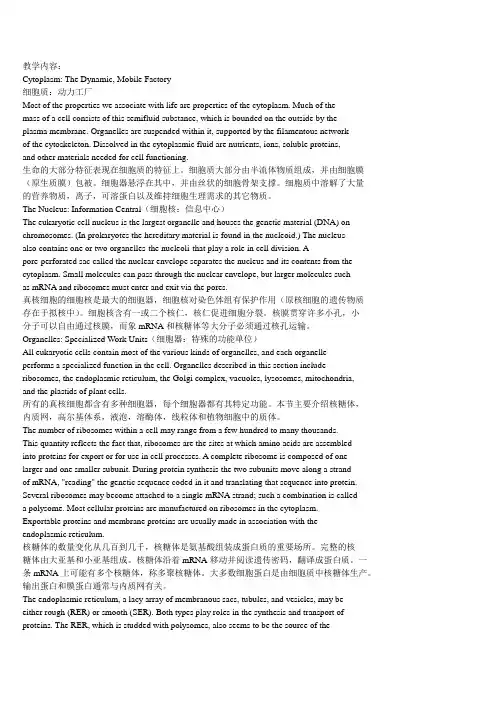
教学内容:Cytoplasm: The Dynamic, Mobile Factory细胞质:动力工厂Most of the properties we associate with life are properties of the cytoplasm. Much of themass of a cell consists of this semifluid substance, which is bounded on the outside by theplasma membrane. Organelles are suspended within it, supported by the filamentous networkof the cytoskeleton. Dissolved in the cytoplasmic fluid are nutrients, ions, soluble proteins,and other materials needed for cell functioning.生命的大部分特征表现在细胞质的特征上。
细胞质大部分由半流体物质组成,并由细胞膜(原生质膜)包被。
细胞器悬浮在其中,并由丝状的细胞骨架支撑。
细胞质中溶解了大量的营养物质,离子,可溶蛋白以及维持细胞生理需求的其它物质。
The Nucleus: Information Central(细胞核:信息中心)The eukaryotic cell nucleus is the largest organelle and houses the genetic material (DNA) on chromosomes. (In prokaryotes the hereditary material is found in the nucleoid.) The nucleusalso contains one or two organelles-the nucleoli-that play a role in cell division. Apore-perforated sac called the nuclear envelope separates the nucleus and its contents from the cytoplasm. Small molecules can pass through the nuclear envelope, but larger molecules suchas mRNA and ribosomes must enter and exit via the pores.真核细胞的细胞核是最大的细胞器,细胞核对染色体组有保护作用(原核细胞的遗传物质存在于拟核中)。
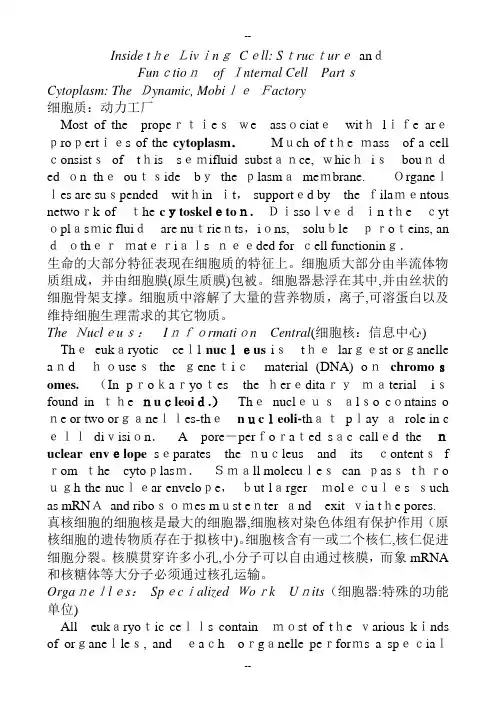
Inside the LivingCell: StructureandFunctionof Internal Cell PartsCytoplasm: The Dynamic, MobileFactory细胞质:动力工厂Most of the propertieswe associatewithlife areproperties of the cytoplasm.Much of the mass of a cell consistsof this semifluid substance, whichisbounded on theoutside bythe plasmamembrane.Organelles are suspended within it,supported by the filamentous network ofthe cytoskeleton. Dissolvedin thecyt oplasmic fluidare nutrients,ions,solubleproteins, an dothermaterials needed for cell functioning.生命的大部分特征表现在细胞质的特征上。
细胞质大部分由半流体物质组成,并由细胞膜(原生质膜)包被。
细胞器悬浮在其中,并由丝状的细胞骨架支撑。
细胞质中溶解了大量的营养物质,离子,可溶蛋白以及维持细胞生理需求的其它物质。
The Nucleus:Information Central(细胞核:信息中心)Theeukaryotic cell nucleus isthelargest organelle andhousesthe geneticmaterial (DNA) onchromosomes.(In prokaryotes the hereditarymaterial isfound in the nucleoid.)Thenucleusalso contains o ne or two organelles-thenucleoli-thatplay arole in c elldivision.A pore-perforated sac called thenuclear envelope separates the nucleus and itscontentsf rom the cytoplasm.Small moleculescan passthro ugh the nuclear envelope,but largermolecules such as mRNAand ribosomes must enter and exit via the pores. 真核细胞的细胞核是最大的细胞器,细胞核对染色体组有保护作用(原核细胞的遗传物质存在于拟核中)。
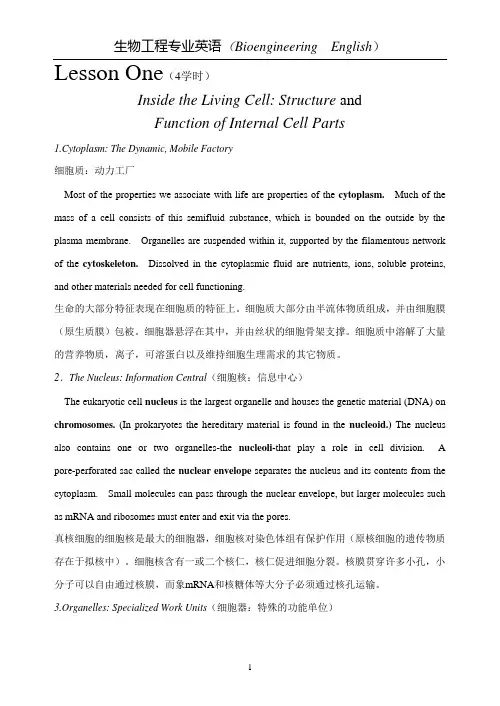
Lesson One(4学时)Inside the Living Cell: Structure andFunction of Internal Cell Parts1.Cytoplasm: The Dynamic, Mobile Factory细胞质:动力工厂Most of the properties we associate with life are properties of the cytoplasm. Much of the mass of a cell consists of this semifluid substance, which is bounded on the outside by the plasma membrane. Organelles are suspended within it, supported by the filamentous network of the cytoskeleton. Dissolved in the cytoplasmic fluid are nutrients, ions, soluble proteins, and other materials needed for cell functioning.生命的大部分特征表现在细胞质的特征上。
细胞质大部分由半流体物质组成,并由细胞膜(原生质膜)包被。
细胞器悬浮在其中,并由丝状的细胞骨架支撑。
细胞质中溶解了大量的营养物质,离子,可溶蛋白以及维持细胞生理需求的其它物质。
2.The Nucleus: Information Central(细胞核:信息中心)The eukaryotic cell nucleus is the largest organelle and houses the genetic material (DNA) on chromosomes. (In prokaryotes the hereditary material is found in the nucleoid.) The nucleus also contains one or two organelles-the nucleoli-that play a role in cell division. A pore-perforated sac called the nuclear envelope separates the nucleus and its contents from the cytoplasm. Small molecules can pass through the nuclear envelope, but larger molecules such as mRNA and ribosomes must enter and exit via the pores.真核细胞的细胞核是最大的细胞器,细胞核对染色体组有保护作用(原核细胞的遗传物质存在于拟核中)。
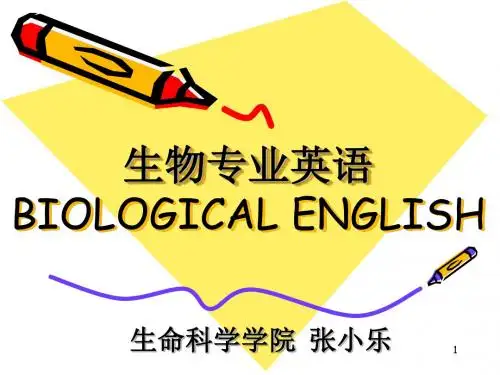
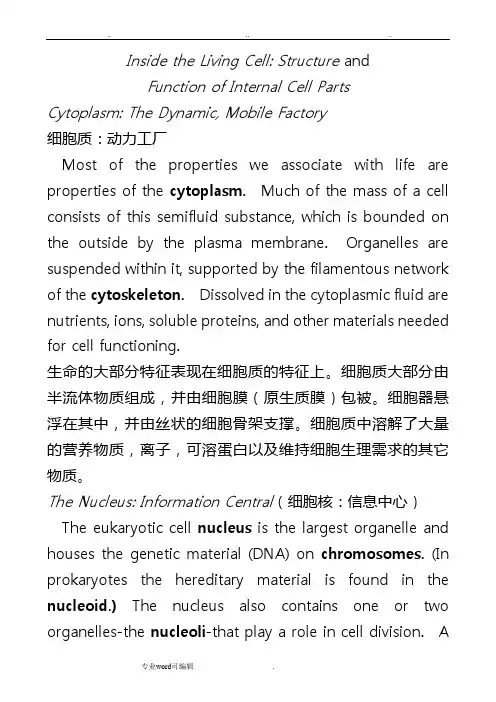
Inside the Living Cell: Structure andFunction of Internal Cell Parts Cytoplasm: The Dynamic, Mobile Factory细胞质:动力工厂Most of the properties we associate with life are properties of the cytoplasm. Much of the mass of a cell consists of this semifluid substance, which is bounded on the outside by the plasma membrane. Organelles are suspended within it, supported by the filamentous network of the cytoskeleton. Dissolved in the cytoplasmic fluid are nutrients, ions, soluble proteins, and other materials needed for cell functioning.生命的大部分特征表现在细胞质的特征上。
细胞质大部分由半流体物质组成,并由细胞膜(原生质膜)包被。
细胞器悬浮在其中,并由丝状的细胞骨架支撑。
细胞质中溶解了大量的营养物质,离子,可溶蛋白以及维持细胞生理需求的其它物质。
The Nucleus: Information Central(细胞核:信息中心)The eukaryotic cell nucleus is the largest organelle and houses the genetic material (DNA) on chromosomes. (In prokaryotes the hereditary material is found in the nucleoid.) The nucleus also contains one or two organelles-the nucleoli-that play a role in cell division. Apore-perforated sac called the nuclear envelope separates the nucleus and its contents from the cytoplasm. Small molecules can pass through the nuclear envelope, but larger molecules such as mRNA and ribosomes must enter and exit via the pores.真核细胞的细胞核是最大的细胞器,细胞核对染色体组有保护作用(原核细胞的遗传物质存在于拟核中)。
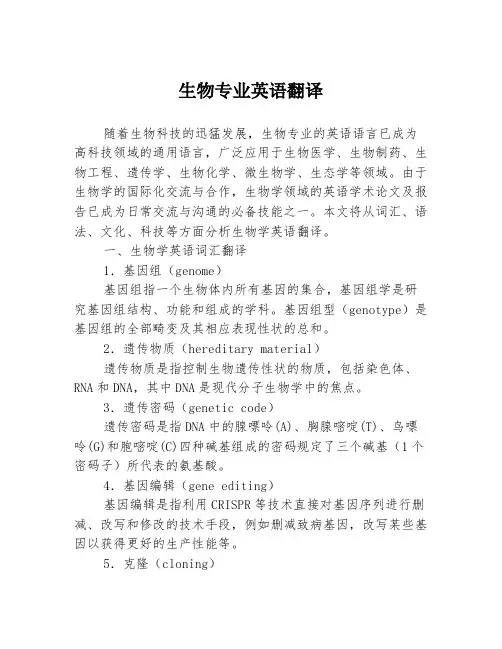
生物专业英语翻译随着生物科技的迅猛发展,生物专业的英语语言已成为高科技领域的通用语言,广泛应用于生物医学、生物制药、生物工程、遗传学、生物化学、微生物学、生态学等领域。
由于生物学的国际化交流与合作,生物学领域的英语学术论文及报告已成为日常交流与沟通的必备技能之一。
本文将从词汇、语法、文化、科技等方面分析生物学英语翻译。
一、生物学英语词汇翻译1.基因组(genome)基因组指一个生物体内所有基因的集合,基因组学是研究基因组结构、功能和组成的学科。
基因组型(genotype)是基因组的全部畸变及其相应表现性状的总和。
2.遗传物质(hereditary material)遗传物质是指控制生物遗传性状的物质,包括染色体、RNA和DNA,其中DNA是现代分子生物学中的焦点。
3.遗传密码(genetic code)遗传密码是指DNA中的腺嘌呤(A)、胸腺嘧啶(T)、鸟嘌呤(G)和胞嘧啶(C)四种碱基组成的密码规定了三个碱基(1个密码子)所代表的氨基酸。
4.基因编辑(gene editing)基因编辑是指利用CRISPR等技术直接对基因序列进行删减、改写和修改的技术手段,例如删减致病基因,改写某些基因以获得更好的生产性能等。
5.克隆(cloning)克隆是指基因重组和复制技术,通过无性繁殖来复制和传输基因,包括植物克隆、动物克隆等。
二、生物学英语语法翻译1.主语与谓语协调主语与谓语协调要求掌握正确的单复数形式和一致性。
例如:The cells in this tissue are actively dividing.(这种组织中的细胞正在活跃地分裂。
)The molecule has a unique structure and function.(该分子具有独特的结构和功能。
)2.形容词和副词的使用在生物化学领域,需要正确地使用形容词和副词,例如:Hereditary information is transmitted through the DNA-encoded chromosome.(遗传信息通过DNA编码的染色体传递。
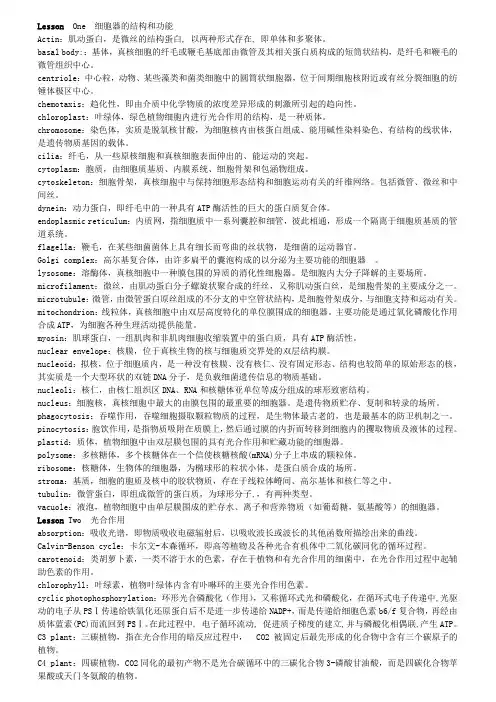
Lesson One 细胞器的结构和功能Actin:肌动蛋白,是微丝的结构蛋白, 以两种形式存在, 即单体和多聚体。
basal body::基体,真核细胞的纤毛或鞭毛基底部由微管及其相关蛋白质构成的短筒状结构,是纤毛和鞭毛的微管组织中心。
centriole:中心粒,动物、某些藻类和菌类细胞中的圆筒状细胞器,位于间期细胞核附近或有丝分裂细胞的纺锤体极区中心。
chemotaxis:趋化性,即由介质中化学物质的浓度差异形成的刺激所引起的趋向性。
chloroplast:叶绿体,绿色植物细胞内进行光合作用的结构,是一种质体。
chromosome:染色体,实质是脱氧核甘酸,为细胞核内由核蛋白组成、能用碱性染料染色、有结构的线状体,是遗传物质基因的载体。
cilia:纤毛,从一些原核细胞和真核细胞表面伸出的、能运动的突起。
cytoplasm:胞质,由细胞质基质、内膜系统、细胞骨架和包涵物组成。
cytoskeleton:细胞骨架,真核细胞中与保持细胞形态结构和细胞运动有关的纤维网络。
包括微管、微丝和中间丝。
dynein:动力蛋白,即纤毛中的一种具有ATP酶活性的巨大的蛋白质复合体。
endoplasmic reticulum:内质网,指细胞质中一系列囊腔和细管,彼此相通,形成一个隔离于细胞质基质的管道系统。
flagella:鞭毛,在某些细菌菌体上具有细长而弯曲的丝状物,是细菌的运动器官。
Golgi complex:高尔基复合体,由许多扁平的囊泡构成的以分泌为主要功能的细胞器。
lysosome:溶酶体,真核细胞中一种膜包围的异质的消化性细胞器。
是细胞内大分子降解的主要场所。
microfilament:微丝,由肌动蛋白分子螺旋状聚合成的纤丝,又称肌动蛋白丝,是细胞骨架的主要成分之一。
microtubule:微管,由微管蛋白原丝组成的不分支的中空管状结构,是细胞骨架成分,与细胞支持和运动有关。
mitochondrion:线粒体,真核细胞中由双层高度特化的单位膜围成的细胞器。
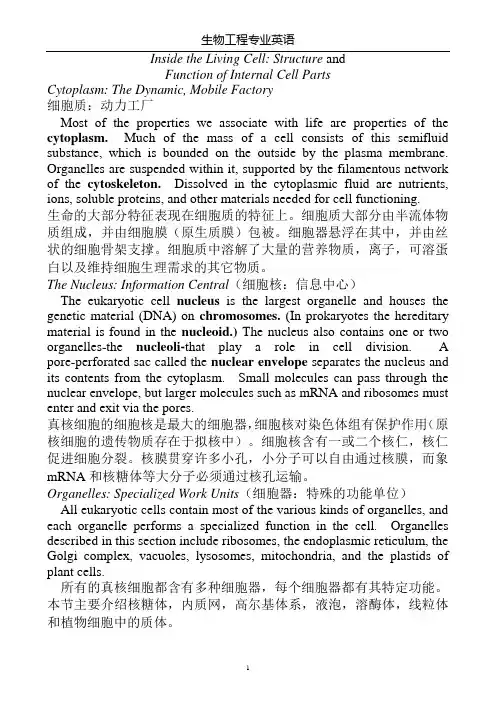
Inside the Living Cell: Structure andFunction of Internal Cell PartsCytoplasm: The Dynamic, Mobile Factory细胞质:动力工厂Most of the properties we associate with life are properties of the cytoplasm. Much of the mass of a cell consists of this semifluid substance, which is bounded on the outside by the plasma membrane. Organelles are suspended within it, supported by the filamentous network of the cytoskeleton. Dissolved in the cytoplasmic fluid are nutrients, ions, soluble proteins, and other materials needed for cell functioning.生命的大部分特征表现在细胞质的特征上。
细胞质大部分由半流体物质组成,并由细胞膜(原生质膜)包被。
细胞器悬浮在其中,并由丝状的细胞骨架支撑。
细胞质中溶解了大量的营养物质,离子,可溶蛋白以及维持细胞生理需求的其它物质。
The Nucleus: Information Central(细胞核:信息中心)The eukaryotic cell nucleus is the largest organelle and houses the genetic material (DNA) on chromosomes. (In prokaryotes the hereditary material is found in the nucleoid.) The nucleus also contains one or two organelles-the nucleoli-that play a role in cell division. A pore-perforated sac called the nuclear envelope separates the nucleus and its contents from the cytoplasm. Small molecules can pass through the nuclear envelope, but larger molecules such as mRNA and ribosomes must enter and exit via the pores.真核细胞的细胞核是最大的细胞器,细胞核对染色体组有保护作用(原核细胞的遗传物质存在于拟核中)。
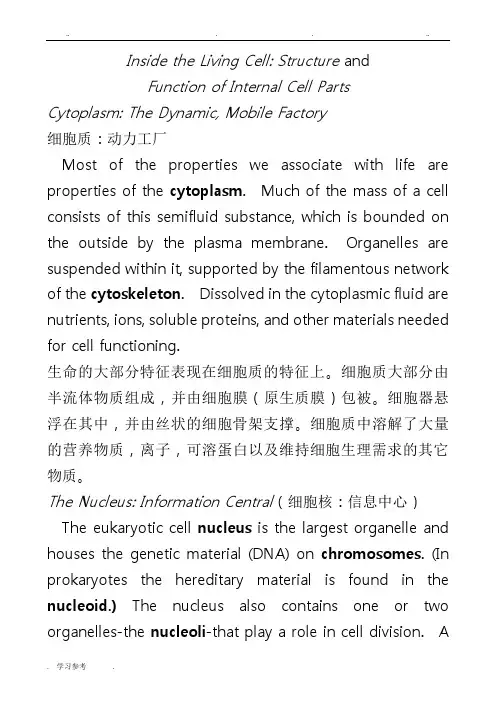
Inside the Living Cell: Structure andFunction of Internal Cell Parts Cytoplasm: The Dynamic, Mobile Factory细胞质:动力工厂Most of the properties we associate with life are properties of the cytoplasm. Much of the mass of a cell consists of this semifluid substance, which is bounded on the outside by the plasma membrane. Organelles are suspended within it, supported by the filamentous network of the cytoskeleton. Dissolved in the cytoplasmic fluid are nutrients, ions, soluble proteins, and other materials needed for cell functioning.生命的大部分特征表现在细胞质的特征上。
细胞质大部分由半流体物质组成,并由细胞膜(原生质膜)包被。
细胞器悬浮在其中,并由丝状的细胞骨架支撑。
细胞质中溶解了大量的营养物质,离子,可溶蛋白以及维持细胞生理需求的其它物质。
The Nucleus: Information Central(细胞核:信息中心)The eukaryotic cell nucleus is the largest organelle and houses the genetic material (DNA) on chromosomes. (In prokaryotes the hereditary material is found in the nucleoid.) The nucleus also contains one or two organelles-the nucleoli-that play a role in cell division. Apore-perforated sac called the nuclear envelope separates the nucleus and its contents from the cytoplasm. Small molecules can pass through the nuclear envelope, but larger molecules such as mRNA and ribosomes must enter and exit via the pores.真核细胞的细胞核是最大的细胞器,细胞核对染色体组有保护作用(原核细胞的遗传物质存在于拟核中)。
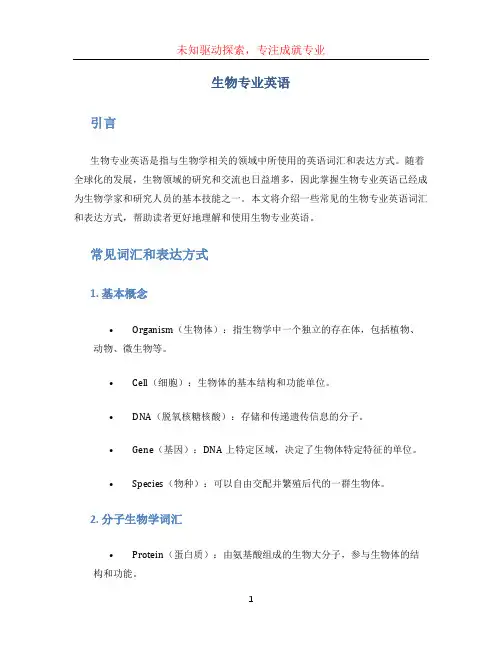
生物专业英语引言生物专业英语是指与生物学相关的领域中所使用的英语词汇和表达方式。
随着全球化的发展,生物领域的研究和交流也日益增多,因此掌握生物专业英语已经成为生物学家和研究人员的基本技能之一。
本文将介绍一些常见的生物专业英语词汇和表达方式,帮助读者更好地理解和使用生物专业英语。
常见词汇和表达方式1. 基本概念•Organism(生物体):指生物学中一个独立的存在体,包括植物、动物、微生物等。
•Cell(细胞):生物体的基本结构和功能单位。
•DNA(脱氧核糖核酸):存储和传递遗传信息的分子。
•Gene(基因):DNA上特定区域,决定了生物体特定特征的单位。
•Species(物种):可以自由交配并繁殖后代的一群生物体。
2. 分子生物学词汇•Protein(蛋白质):由氨基酸组成的生物大分子,参与生物体的结构和功能。
•Enzyme(酶):催化生物体内化学反应的蛋白质。
•Expression(表达):基因在蛋白质水平上的转录和翻译过程。
•Mutation(突变):基因序列的突发性改变,可能导致生物体表现出不同的特征。
•Polymerase Chain Reaction(聚合酶链反应):一种用于扩增DNA 分子的技术。
3. 遗传学词汇•Heredity(遗传):生物特征通过基因传递给后代的过程。
•Allele(等位基因):基因的不同变体。
•Genotype(基因型):生物体内基因的组合。
•Phenotype(表型):基因型在外部可观察到的表现。
•Genetic Variation(遗传变异):生物体内基因和等位基因的变异。
4. 生态学词汇•Ecosystem(生态系统):由生物体和环境相互作用组成的一个自然单位。
•Biodiversity(生物多样性):生物体种类和数量的多样性。
•Food Chain(食物链):生物体之间通过食物相互联系的关系网。
•Conservation(保护):保护自然资源和环境,维护生物多样性的活动。
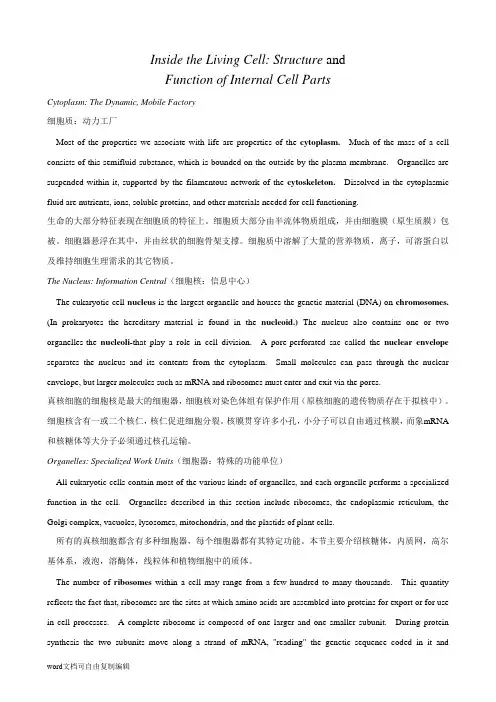
Inside the Living Cell: Structure andFunction of Internal Cell PartsCytoplasm: The Dynamic, Mobile Factory细胞质:动力工厂Most of the properties we associate with life are properties of the cytoplasm. Much of the mass of a cell consists of this semifluid substance, which is bounded on the outside by the plasma membrane. Organelles are suspended within it, supported by the filamentous network of the cytoskeleton. Dissolved in the cytoplasmic fluid are nutrients, ions, soluble proteins, and other materials needed for cell functioning.生命的大部分特征表现在细胞质的特征上。
细胞质大部分由半流体物质组成,并由细胞膜(原生质膜)包被。
细胞器悬浮在其中,并由丝状的细胞骨架支撑。
细胞质中溶解了大量的营养物质,离子,可溶蛋白以及维持细胞生理需求的其它物质。
The Nucleus: Information Central(细胞核:信息中心)The eukaryotic cell nucleus is the largest organelle and houses the genetic material (DNA) on chromosomes. (In prokaryotes the hereditary material is found in the nucleoid.) The nucleus also contains one or two organelles-the nucleoli-that play a role in cell division. A pore-perforated sac called the nuclear envelope separates the nucleus and its contents from the cytoplasm. Small molecules can pass through the nuclear envelope, but larger molecules such as mRNA and ribosomes must enter and exit via the pores.真核细胞的细胞核是最大的细胞器,细胞核对染色体组有保护作用(原核细胞的遗传物质存在于拟核中)。
专业英语单词整理haplo,mono,uni:单,一,独haploid 单倍体;monoxide 一氧化物bi,di,dipl,twi,du: 二,双,两,偶dichromatic 双色的;diplobacillus 双杆菌tri: 三,丙triangle 三角;triacylglycerol 三酰甘油quadri,quadru,quart,tetr,tetra:四quadruped 四足动物;tetracycline 四环素pent,penta,quique: 五pentose 戊糖;pentane 戊烷hex,hexa,sex: 六hexose 已糖hexapod 六足动物;hexamer 六聚体hepta,sept(i): 七heptane 庚烷heptose 庚糖heptoglobin 七珠蛋白oct: 八octopus 章鱼octagon 八角形octane 辛烷octase 辛糖ennea,nona: 九nonapeptide 九肽enneahedron 九面体deca,deka: 十decapod 十足目动物decahedron 十面体decagram 十克demi-,hemi-,semi-: 半hemicerebrum 大脑半球;semiopaque 半透明holo-: 全,整体,完全holoenzyme 全酶;holocrine 全分泌mega-: 巨大,兆,百万megaspore 大孢子;megakaryocyte 巨核细胞macro-: 大,巨大,多macrophage 巨噬细胞;macromolecular 大分子的poly-,multi-,mult-: 多,复合polyacrylate 聚丙烯酸酯;polymerase 聚合酶ab- 去,离开abarticular 关节外的;abaxial 离轴的acro- 顶,向顶acrosome 顶体;acrospire 顶芽,初生叶Ambi-, amb-, ambo- 两侧,二,复ambiopia 复视;ambosexual 两性的amphi- 二,两,双amphibia 两栖类;amphinucleoli 双核仁pan- 完全panagglutination 全凝集;panarthritis 全关节炎-ase 酶protease 蛋白酶;polymerase 聚合酶-ate 盐,酯phosphate 磷酸盐;sebacate 奎二酸酯-gen 原,剂antigen 抗原;mutagen 诱变剂-ose 糖heptose 庚糖,lactose 乳糖-some 体,粒chromosome 染色体;idiosome 核旁体-phil 亲,嗜,喜acidophil 嗜酸的,aerophil 好气的-derm 皮,皮层;derma- blastoderm 胚层;dermadrone 内病性皮疹-lemma 皮,壳,鞘膜basilemma 基底膜;lemmatoxin 鞘毒素-nema 丝,线amphinema 偶线;chromonema 染色线;nemacicide 杀线虫剂-osic 病,症;-itis acalcicosis缺钙症;hepatitis 肝炎Bacteri(o): 细菌bacteriocin 细菌素;bacteriophage 嗜菌体Biosis: 生命anhydrobiosis 脱水生活;dysbiosis 生态失调Carbo: 碳carbocyclic 碳环的;carbonate 碳酸盐Carcin(o): 癌carcinogen 致癌物;carcinocidin 消癌菌素Caryo: 核eucaryotic 真核的,caryogenesis 核发生Chemo: 化学chemotherapy 化学疗法;chemoautotrophy 化能自养(生物) Chlor(o): 绿,氯chlorophilline 叶绿素;chlorophore 载绿体;chloride 氯化物Chondri(o): 软骨,颗,粒chondriglucose 软骨葡萄糖;chondriosome 线粒体Eryth(ro): 红erythromycin 红霉素;erythrocyte 红血球Embryo: 胚胎embryogenesis 胚胎发生;embryoblast 成胚细胞Dys-: 不良,异常,障碍dys-cyclia 循环障碍;dysembryoma 畸胎瘤Eu-: 常,真,好eucaryote 真核生物;eubacteria 真细菌Exo-: 外exon 外显子;exonuclease 核酸外切酶Idio-: 独有,特异idiobiology 个体生物学;idioblast 异细胞Iso-: 等,同,异isozyme 同功酶;isotropic 各向同性的;isopropanol 异丙醇Hetero-: 异,杂,不同heterocyclic 杂环的; heterochromosome 异染色体Homeo-: 同祖,(部分)同源homeoallele 部分同源等位基因;homeotransplant 同种移植Homo-: 同,同源,高homocaryon 同核体;homocysteine 高半胱氨酸;homothermal 恒温的Hyalo-: 玻璃、透明hyaloplasm 透明质;hyalospore 无色孢子Cardia(o): 心amyocardia 心肌无力;angiocardiopathy 心血管病;bradycardia 心动过缓Cryo: 冷,冻cryoadhesion 冷冻粘结;cryoalgae 冰雪藻类Feti(o): 胎feticide 堕胎;fetoscopy 胎镜Fibr(o): 纤维fibroblast 成纤维细胞;fibrocarcinoma 纤维癌Flav: 黄flavoprotein 黄素蛋白;thioflavin 硫磺素Lip(o)-: 脂(的)lipophilic 亲脂的;lipoadenoma 脂肪腺瘤Lys(o)-: 溶、解、分、离lysozyme 溶菌酶;lysate 溶解产物;lysophagosome 吞噬溶酶体Leuc(o)-: 无色、白、白细胞leucoagglutinin 白细胞凝集素;leucogenenol 促白细胞生成素Melan(o)-: 黑melanophore 载黑素细胞;melanocarcinoma 黑素细胞癌Telo-: 端,末尾telophase 有丝分裂末期;telomerase 端粒酶Morpho: 形、形态amorphous 无定形的;morphogenesis 形态发生Myo: 肌肉myoglobin 肌球蛋白;myoadenofibroma 肌腺纤维瘤Neuro: 神经neuroangiomatosis 神经血管瘤病;neuroepidermal 神经表皮的Meso: 中、介mesoderm 中胚层;mesozoic 中生代的Meta: 异、变、偏、次、后、中、转metachrome 异染色体;metamorphosis 变形Organ(o): 器官,有机organacidia 有机酸症organelle 细胞器Ion: 离子anion 阴离子;zwitterion 两性离子Reticul(o): 网reticulocyte 网织红细胞;reticuloendothelial 网状内皮的Vacuo: 空,泡,管vacuoplast 液泡体;vacuolus 液泡Tox: 毒toxin 毒素;toxemia 毒血症Fluor(o): 氟,荧光fluorochrome 荧光染料;fluorescence 荧光Gam: 性,婚配、gamete 配子;gamic 受精的Geno: 遗传,基因,种族,生殖genotype 基因型;genopathy 遗传病Glyc(o),Gluc(o): 甜、糖glycoside 糖苷;glucohemia 糖血症Gyno: 雌性gynogamone 雌配素;gynospore 雌孢子H(a)emo: 血haemoglobin 血红蛋白;hemocyanin 血蓝蛋白Helio: 太阳、光heliophilous 喜阳的;heliosis 中暑Hist(o): 组织histocompatibility 组织相容性;histidine 组氨酸;histone 组蛋白Immuno: 免疫immunoautoradiography 免疫放射自显影Kine(to): 动kinetin 激动蛋白;kinetochore 动粒,着丝点Onco 肿瘤, 癌oncogene,致癌基因;oncolysis溶癌作用;oncovirus致癌病毒O(v)o 卵,蛋oocyte卵母细胞, oocyan卵清蛋白, ovogenesis卵子发生Patho 病pathotoxins疾病毒素, pathobolism 病理代谢Peri 周,围pericardial,心周的;perikaryon核周体Phospho 磷酸phosphodiester 磷酸二酯Phyto 植物phytokinase,植物激酶phytoferritin 植物铁蛋白Proto 原,初protofibril,原纤维protolignin原木质素Pseudo 假,拟pseudoembryo, 假胚胎pseudodominance 拟显性Vertebrate 脊椎动物Rodent 啮齿动物Reptile爬行动物Amphibian 两栖动物Protozoan 原生动物Primate灵长类动物homo sapiens人类abdomen 腹部gall bladder 胆囊pancreas 胰腺spleen 脾duodenum 十二指肠small intestine小肠large intestine 大肠 blind gut 盲肠vermiform appendix阑尾 rectum 直肠anus 肛门hip 臀部joint 关节vein 静脉capillary 毛细血管windpipe 气管gullet 食管。
Lesson One 细胞器的结构和功能Actin:肌动蛋白,是微丝的结构蛋白, 以两种形式存在, 即单体和多聚体;basal body::基体,真核细胞的纤毛或鞭毛基底部由微管及其相关蛋白质构成的短筒状结构,是纤毛和鞭毛的微管组织中心;centriole:中心粒,动物、某些藻类和菌类细胞中的圆筒状细胞器,位于间期细胞核附近或有丝分裂细胞的纺锤体极区中心;chemotaxis:趋化性,即由介质中化学物质的浓度差异形成的刺激所引起的趋向性;chloroplast:叶绿体,绿色植物细胞内进行光合作用的结构,是一种质体;chromosome:染色体,实质是脱氧核甘酸,为细胞核内由核蛋白组成、能用碱性染料染色、有结构的线状体,是遗传物质基因的载体;cilia:纤毛,从一些原核细胞和真核细胞表面伸出的、能运动的突起;cytoplasm:胞质,由细胞质基质、内膜系统、细胞骨架和包涵物组成;cytoskeleton:细胞骨架,真核细胞中与保持细胞形态结构和细胞运动有关的纤维网络;包括微管、微丝和中间丝;dynein:动力蛋白,即纤毛中的一种具有ATP酶活性的巨大的蛋白质复合体;endoplasmic reticulum:内质网,指细胞质中一系列囊腔和细管,彼此相通,形成一个隔离于细胞质基质的管道系统;flagella:鞭毛,在某些细菌菌体上具有细长而弯曲的丝状物,是细菌的运动器官;Golgi complex:高尔基复合体,由许多扁平的囊泡构成的以分泌为主要功能的;lysosome:溶酶体,真核细胞中一种膜包围的异质的消化性细胞器;是细胞内大分子降解的主要场所; microfilament:微丝,由肌动蛋白分子螺旋状聚合成的纤丝,又称肌动蛋白丝,是细胞骨架的主要成分之一; microtubule:微管,由微管蛋白原丝组成的不分支的中空管状结构,是细胞骨架成分,与细胞支持和运动有关; mitochondrion:线粒体,真核细胞中由双层高度特化的单位膜围成的细胞器;主要功能是通过氧化磷酸化作用合成ATP,为细胞各种生理活动提供能量;myosin:肌球蛋白,一组肌肉和非肌肉细胞收缩装置中的蛋白质,具有ATP酶活性;nuclear envelope:核膜,位于真核生物的核与细胞质交界处的双层结构膜;nucleoid:拟核,位于细胞质内,是一种没有核膜、没有核仁、没有固定形态、结构也较简单的原始形态的核,其实质是一个大型环状的双链DNA分子,是负载细菌遗传信息的物质基础;nucleoli:核仁,由核仁组织区DNA、RNA和核糖体亚单位等成分组成的球形致密结构;nucleus:细胞核,真核细胞中最大的由膜包围的最重要的细胞器;是遗传物质贮存、复制和转录的场所; phagocytosis:吞噬作用,吞噬细胞摄取颗粒物质的过程,是生物体最古老的,也是最基本的防卫机制之一; pinocytosis:胞饮作用,是指物质吸附在质膜上,然后通过膜的内折而转移到细胞内的攫取物质及液体的过程; plastid:质体,植物细胞中由双层膜包围的具有光合作用和贮藏功能的细胞器;polysome:多核糖体,多个核糖体在一个信使核糖核酸mRNA分子上串成的颗粒体;ribosome:核糖体,生物体的细胞器,为椭球形的粒状小体,是蛋白质合成的场所;stroma:基质,细胞的胞质及核中的胶状物质,存在于线粒体嵴间、高尔基体和核仁等之中;tubulin:微管蛋白,即组成的,为球形分子,,有两种类型;vacuole:液泡,植物细胞中由单层膜围成的贮存水、离子和营养物质如葡萄糖,氨基酸等的细胞器;Lesson Two 光合作用absorption:吸收光谱,即物质吸收电磁辐射后,以吸收波长或波长的其他函数所描绘出来的曲线;Calvin-Benson cycle:卡尔文-本森循环,即高等植物及各种光合有机体中二氧化碳同化的循环过程; carotenoid:类胡萝卜素,一类不溶于水的色素,存在于植物和有光合作用的细菌中,在光合作用过程中起辅助色素的作用;chlorophyll:叶绿素,植物叶绿体内含有卟啉环的主要光合作用色素;cyclic photophosphorylation:环形光合磷酸化作用,又称循环式光和磷酸化,在循环式电子传递中,光驱动的电子从PSⅠ传递给铁氧化还原蛋白后不是进一步传递给NADP+,而是传递给细胞色素b6/f复合物,再经由质体蓝素PC而流回到PSⅠ;在此过程中, 电子循环流动, 促进质子梯度的建立,并与磷酸化相偶联,产生ATP;C3 plant:三碳植物,指在光合作用的暗反应过程中, CO2被固定后最先形成的化合物中含有三个碳原子的植物;C4 plant:四碳植物,CO2同化的最初产物不是光合碳循环中的三碳化合物3-磷酸甘油酸,而是四碳化合物苹果酸或天门冬氨酸的植物;light-dependent reactions:光反应,通过叶绿素等光合色素分子吸收、传递光能,并将光能转化为化学能,形成ATP和NADPH的过程;light-independent reactions:暗反应,利用产生的和这两个高能化合物分别作为能源和还原的动力将CO2固定,使之转变成葡萄糖, 由于这一过程不需要光;noncyclic photophosphorylation:非环形光合磷酸化作用,在线性电子传递中,光驱动的电子经两个光系统最后传递给NADP+,并在电子传递过程中建立H+质子梯度,驱使ADP磷酸化产生ATP;photon:光子,传递电磁相互作用的基本粒子,是一种规范玻色子;photophosphrylation:光合磷酸化作用,由光照引起的电子传递与磷酸化作用相偶联而生成ATP的过程; photorespiration:光呼吸,光合作用细胞在光照条件下,消耗ATP、产生二氧化碳的反应;photosynthesis:光合作用,光合生物吸收太阳的光能转变为化学能,再利用自然界的二氧化碳和水,产生各种有机物的过程;photosystem:光合系统,能够吸收光能并参与光合作用光反应的一种光合色素或一组色素;ribulose biphosphate:核酮糖二磷酸,是在中的里起重要作用的一种五碳糖;thylakoid:类囊体,在叶绿体基质中,是单层膜围成的扁平小囊;Lesson Three 有丝分裂和减数分裂anaphase:分裂后期,的后期,每一个分裂成两个,原来连接在同一个着丝点上的两条也随着分离开来,成为两条子;cell plate:细胞板,高等植物细胞分裂末期,在隔膜形成体的中央生成的薄膜结构;centromere:着丝粒,是真核生物细胞在进行有丝分裂mitosis和减数分裂meiosis时,染色体分离的一种“装置”;★chalone:抑素,物的各器官、组织中所含的一种特异的抑制细胞分裂物质;chromatid:染色单体,染色体复制后仍由着丝粒部位连在一起的两条子染色体;chromatin:染色质,是真核细胞的间期核中DNA,组蛋白,非组蛋白蛋白质以及少量RNA所组成的一串念珠状复合体;cytokinesis:胞质分裂,细胞分裂过程中,继核分裂后,细胞质一分为二分配到两个完整子细胞中的过程; diploid:二倍体,凡是由受精卵发育而来,且体细胞中含有两个染色体组的生物个体;haploid:单倍体,具有和该物种配子染色体数相同的细胞或个体;★histone:组蛋白,是指所有的细胞中,与结合存在的碱性蛋白质的总称;homologous pair:同源染色体对,一条来自父本,一条来自母本,且形态、大小相同,在减数分裂前期相互配对的染色体;interphasecycle:分裂间期周期,指细胞在一次分裂结束之后到下一次分裂之前的这一段时间;karyotype:核型,指染色体组在有丝分裂中期的表型, 是染色体数目、大小、形态特征的总和;★meiosis:减数分裂,性细胞分裂时,染色体只复制一次,细胞连续分裂两次,染色体数目减半的一种特殊分裂方式;★mitosis:有丝分裂,真核细胞的细胞核分裂涉及DNA浓缩成可见的染色体和出现纺锤体的一种细胞分裂类型; metaphase:分裂中期,在细胞有丝分裂中,从染色体排列到赤道面上,到它们的染色单体开始分向两极之前这段时间;metaphase plate:赤道板,是细胞有丝分裂中期,染色体的着丝点排列在细胞中央的平面上,这个平面在细胞的中央,就是赤道板,但是个虚拟平面,并不是真实存在;nucleosome:核小体,组成真核细胞染色体的基本结构单位,由组蛋白和大约200个bp的DNA组成的直径约10 nm 的球形小体;prophase:分裂前期,细胞有丝分裂自分裂期开始到解体为止的时期;spindle:纺锤体,产生于细胞分裂细胞分裂前初期到末期的一个特殊细胞器,和染色体运动密切相关; telophase:分裂末期,细胞有丝分裂中每条染色体的两条姊妹染色单体分开并移向两极的时期;Lesson Four 遗传学基本原理allele:等位基因,位于同源染色体的同一位置上的基因;dominant:显性,由显性等位基因决定的,在杂合状态下性状得以表现的现象;★recessive:隐性的,在杂合状态下,隐性等位基因支配的性状不表现的现象;dihybrid cross:双因子杂合子杂交,在两个不同的基因座位上两对等位基因是杂合的个体杂交;gene:基因,DNA分子上具有遗传信息的特定核苷酸序列的总称,是具有遗传效应的DNA分子片段;genotype:基因型:指生物的遗传型,即控制性状的基因组合类型;phenotype:表现型,;具有特定基因型的个体,在一定环境条件下,所表现出来的性状特征的总和;germ plasm theory:种质学说,由魏斯曼提出的学说,认为生物体由种质和体质组成,遗传必须通过种质,而获得性状不能遗传,体质是由种质分化而来;heterozygous:杂合的,具有两个不同基因成员的二倍体;homozygous:纯合的,具有两个相同基因成员的二倍体;incomplete dominance:不完全显性,具有相对性状的纯合亲本杂交后,F1显现中间类型的现象;law of independent assortment:独立分配定律,指当两对以上的等位基因进入一个配子时,它们相互之间是独立自由组合的,后代基因型是雌配子和雄性配子随机受精决定的;law of segregation:分离定律,一对基因在杂合状态中保持相对的独立性,而在配子形成时,又按原样分离到不同配子中去的现象;nondisjunction:不分离,指在细胞减数分裂时某些配对的染色体没能分裂开来;★pangenesis:泛生论,为晚年所提出,用来说明能遗传的一个理论;认为生物体各部分的细胞都带有特定的自身繁殖称为的粒子,称为“微芽”或“”;Punnett square:庞纳特方格,一个个体可能产生的配子延方格的水平面列出,另一个体可能产生的配子延方格的垂直面列出,子代可能产生的基因型填在方格中;test cross:测交, 为了确定F1是杂合子还是纯合子,让F1代与隐性纯合子杂交;Lesson Five 基因的化学性质purine:嘌呤,指一类带碱性有两个相邻的碳氮环的含氮化合物,是核酸的组成成分;pyrimidine:嘧啶,一类带碱性有一个碳氮环的含氮化合物,是核酸的组成成分;adenine:腺嘌呤,是DNA和RNA中的一种,缩写为A,在DNA中与T配对;在中,它与U配对;guanine:鸟嘌呤,是嘌呤类有机化合物,是嘌呤的一种,由碳和氮原子组成具有特征性双环结构,并与以三个氢键相连;cytosine:胞嘧啶,简写为C,中嘧啶型碱基之一,与鸟嘌呤配对;thymine:胸腺嘧啶,简写为T,中嘧啶型碱基之一,与腺嘌呤配对;★DNA polymerase:DNA聚合酶,以单链或双链DNA为模板,催化由脱氧核糖核苷三磷酸合成DNA的酶;★double helix:双螺旋,是一种核酸的构象,在该构象中,两条反向平行的多核甘酸链相互缠绕形成一个右手的双螺旋结构;nucleoside:核苷,原指来自的嘌呤和嘧啶糖苷,现已扩展至其他天然和合成的杂环碱基核糖苷,也包括糖上的C1连接到杂环碱的氧原子或碳原子上的化合物;Okazaki fragment:冈崎片段,是DNA复制过程中,一段属于不连续合成的延迟股,且相对来说长度较短的DNA 片段;one-gene-one-enzyme hypothesis:一基因一酶假说,认为基因是通过控制酶和其他蛋白质合成来控制细胞代谢的,一个基因的缺陷引起一种酶的变化,从而产生一种遗传性状;one-gene-one-polypeptide hypothesis:一基因一多肽假说,一个基因决定一条多肽链合成的假说,该假说已替代了一基因一酶假说;replication fork:复制叉,DNA复制时在DNA链上通过解旋、解链和SSB蛋白的结合等过程形成的Y字型结构; semiconservative replication:半保留复制,DNA复制时以双链中的每一条单链作为模板,分别合成一条互补新链,重新形成的双链中各保留一条原有DNA单链;X-ray diffraction:X射线衍射,X射线受到原子核外电子的散射而发生的衍射现象;Lesson Six 生命的起源和多样性Big Bang:大爆炸,描述诞生初始条件及其后续演化的模型;binomial system of nomenclature:双名法,生物学上对生物种类的命名规则,为每个物種命名的名字有两部分构成:属名和种加词;clade:进化枝,通过同源性状分析确定变异的分支序列,用以重建一个分类群的进化史;taxon:分类群,在层级之下的一个物种分类单元;taxonomy:分类学,关于生物分类、鉴定和命名的原理和方法的学科;coacervate:团聚体,生命起源过程中,可能由分子小滴形成的具有类似细胞代谢活性的过渡性结构; continental drift:大陆漂移,大陆彼此之间以及大陆相对于大洋盆地间的大规模水平运动;core:核心,在地幔之下的地球中心结构;mantle:地幔,地壳下面是地球的中间层,由致密的造岩物质构成;crust:地壳,是地球固体圈层的最外层,岩石圈的重要组成部分;ozone layer:臭氧层,指大气层的平流层中臭氧浓度相对较高的部分,其主要作用是吸收短波紫外线; kingdom:界,是生物科学分类法中最高的类别;division:门,介于界和纲之间的生物分类阶元;class:纲,介于门和目之间的生物分类阶元;order:目,是生物分类法中的一级,位于纲和科之间;family:科,是生物分类法中的一级,位于目和属之间;genus:属,是生物分类法中的一级,位于科和种之间;species:种,个体间能进行有性结合、正常繁育后代并且具有相对稳定遗传特性的自然种群;liposome:脂质体,利用磷脂双分子层膜所形成的囊泡包裹药物分子而形成的制剂;proteinoid:类蛋白质,指在干燥状态下加热而成的类似的;Lesson Seven 最大的分解者—真菌ascus:子囊,子囊菌有性过程中进行核配和减数分裂发生的场所;ascomycetes:子囊菌,产生子囊的菌类的总称;conidium:分生孢子子实体,真菌的分生抱子和还着生在分生孢子果内;basidium:担子, 担子菌纲所特有的分生孢子梗;basidiocarp:担子果,又称子实体;担子菌亚门真菌有性生殖阶段形成地特殊结构;basidiomycetes:担子果菌纲,一类高等,基本全为陆生品种,主要特征是由多细胞,有横隔膜的菌丝体组成; Fungi ImperfectiDecteromycetes:半知菌门,一群只有无性阶段或有性阶段未发现的真菌;sporangium:孢子囊,植物或真菌制造并容纳孢子的组织;gametangium:配子囊,和产生的或结构;haustorium:吸器,真菌菌丝某处生出特殊形态的菌丝体或菌丝的变态物,伸入寄主体内吸取养分; heterokaryon:异核体,在同一个细胞质中含有两种或多种不同基因型的细胞核的细胞、孢子或菌丝体; hyphae:菌丝,单条管状细丝,为大多数的结构单位,一些也有菌丝,如放线菌;lichen:地衣,就是真菌和藻类共生的一类特殊植物,无根、茎、叶的分化,能生活在各种环境中; mycelium:菌丝体,由许多菌丝连结在一起组成地营养体类型;rhizoid:假根,由单列细胞组成,是主要的固着和吸收器官;saprobe:腐生菌,属于营腐生生活的;它们从已死的动、植物或其他有机物吸取养料,以维持自身正常生活的一种生活方式;septate:有隔膜的,分隔的:被隔膜分隔开的;Lesson Eight 动物发育acrosome reaction:顶体反应,精子获能后,与卵膜或卵表面相接触,顶体开始产生的一系列改变; fertilization:受精,卵子和精子融合为一个合子的过程;cleavage:卵裂,受精卵经过多次连续迅速的细胞分裂,形成许多小细胞的发育过程;blastomere:卵裂球,是受精卵发育过程所经历过的一个阶段,指的是由受精卵分裂而生成的形态上尚未分化的细胞;blastula:囊胚,胚胎由桑椹胚进一步,的一个中空的球;gastrula:原肠胚,胚胎由囊胚继续发育,由原始的单胚层细胞发展成具有双层或三层胚层结构的胚胎; primitive streak:原条,在鸟类、爬行类和哺乳类胚胎原肠作用时,胚胎后区加厚,并向头区延伸所形成的细胞条;gastrulation:原肠胚形成,早期胚胎由囊胚形成原肠胚的发育过程;ectoderm:外胚层, 后生动物发生过程中所出现的胚层之一,出现在胚的外表面或表面;endoderm:内胚层,为后生动物发生过程所出现的胚层中,位于最内或最下的胚层;mesoderm:中胚层,指在三胚层动物的胚胎发育过程中,原肠胚末期处在外胚层和内胚层之间的细胞层; compensatory hypertrophy:代偿性肥大,某器官的一部分或成对脏器的一侧受到损害或切除时,残余部分或残留的另外一侧脏器则肥大,并出现功能增强的现象;dedifferentiation:脱分化,指分化细胞失去特有的结构和功能变为具有未分化细胞特性的过程; differentiation:分化,生物体发育过程中细胞和组织的结构和功能的变化;gene amplification:基因扩增,生物体发育分化或环境条件的改变,通过增加基因产物的数量,调节表达活性的方式;metamorphosis:变态,指昆虫在不同的发育时期,产生的形态、习性的变化;morphogenesis:形态发生,在发育过程中生成一个器官或结构的过程;neurulation:神经胚形成,脊椎动物胚胎发育过程中处于神经板外胚层发育成神经管阶段的胚胎的过程; oogenesis:卵子发生,卵原细胞形成成熟卵细胞的过程;organogenesis:器官发生,器官形成,一般指脊椎动物个体发育中,由器官原基进而演变为器官的过程; ovaries:卵巢,雌性动物的生殖器官;oviduct:输卵管,从卵巢连至阴道的管道,包括中输卵管和侧输卵管,卵经此排出;ovum:卵,次级卵母细胞经减数分裂产生的动物和植物的成熟的雌性生殖细胞;yolk:卵黄,贮存在动物卵内,专供卵生和卵胎生动物胚胎发育过程中所需的营养物质;sperm:精子,动物和低等植物成熟的雄配子;大小、形态因种类而异;spermatogenesis:精子发生,雄性动物精子的发育和成熟的过程;zygote:受精卵,一个获能的精子完全进入一个次级卵母细胞后形成的细胞;parthenogenesis:孤雌生殖,由未受精的卵单独发育成个体的特殊生殖方式;regeneration:再生,生物体对失去的结构重新自我修复和替代的过程;Lesson Nine 物种的起源allopatric speciation:异域物种形成,栖居于不同地域,因地理隔离而形成新物种的方式;sympatric speciation:同域物种形成,栖居于相同地域,因生殖隔离而形成新物种的方式;analogy:同功,不同类群生物的器官虽来源和结构不同,却功能相似的现象;cline:梯度变异,某一性状在相邻的一系列连续性种群中呈现出逐渐的、连续的变异;convergent evolution:趋同进化,不同物种在相似的环境中发育出相似的性状的进化过程;divergent evolution:趋异进化,同一物种由于适应不同的环境而呈现出表型差异的进化过程;extinction:灭绝,指某支生物谱系的演化终结或整支谱系的消亡;homology:同源性,进化过程中源于同一祖先的分支之间的关系;hybrid sterility:杂种不育性,不同物种之间杂交的后代不能再繁育可育的后代;macroevolution:宏观进化,指物种和种以上的高级分类群在地质时间尺度上的进化模式、进化趋势和进化速率; microevolution:微进化,是由突变,遗传漂变,基因流和自然选择导致的等位基因频率的改变;parallel evolution:平行进化,指由共同祖先分出来的后代有关进化方面显有同样趋势的现象; phylogeny:种系发生,指在地球历史发展过程中生物种系的发生和发展;punctuated equilibrium:间断平衡,一种有关生物进化模式的学说;即一个系谱长期所处的静止或平衡状态被短期的、爆发性的大进化所打破,伴随着产生大量新物种;Lesson Ten 种群生态学age structure:年龄结构,不同年龄组在种群中所占比例或配置状况;allelopathy:异种相克相成现象,指植物通过向环境释放特定的次生物质从而对邻近其它植物生长发育产生的有益和有害的影响;carrying capacity:容纳量,指特定环境所能容许的种群数量的最大值;character displacement:特征替换,物种间由于竞争或合作而导致的物种特征的改变;density-dependent factors:密度制约因子,系统中对种群的作用大小随种群本身密度变化而变化的因子; density-independent factors:非密度制约因子,系统中对种群的作用大小与密度变化无关的因子; exponential growth curve:指数生长曲线,在自然环境中,种群的增长曲线是一个“J”型曲线;logistic growth curve:逻辑生长曲线,在自然环境中,种群的增长曲线是一个“S”型曲线;interspecific competition:种间竞争,同种群之间为争夺生活空间、资源、食物等出现的竞争; intraspecific competition:种内竞争,同种个体间利用同一资源而发生的相互妨碍作用;mortality:死亡率,单位时间内个体死亡数占初始个体数的比例;natality:出生率,单位时间内种群新出生的个体数与该种群总数之比;population density:种群密度,单位面积或空间中同种生物个体的数量;survivorship curve:存活曲线,描述同期出生的生物种群个体存活过程与其年龄关系的曲线;。
Lesson One(4学时)Inside the Living Cell: Structure andFunction of Internal Cell Parts教学目的:使学生掌握细胞的组成结构(各种细胞器以及它们在细胞中的位置),以及结构与功能之间的关系。
各细胞器及功能相关英语词汇以及主要用法。
教学重点:各细胞器的概念和功能,及相关英语词汇的掌握教学难点:专业英语词汇的记忆讲授方法:以学生翻译为主,老师讲解相关专业知识辅助学生理解授课时间:3月22日;3月29日教学内容:Cytoplasm: The Dynamic, Mobile Factory细胞质:动力工厂Most of the properties we associate with life are properties of the cytoplasm. Much of the mass of a cell consists of this semifluid substance, which is bounded on the outside by the plasma membrane. Organelles are suspended within it, supported by the filamentous network of the cytoskeleton. Dissolved in the cytoplasmic fluid are nutrients, ions, soluble proteins, and other materials needed for cell functioning.生命的大部分特征表现在细胞质的特征上。
细胞质大部分由半流体物质组成,并由细胞膜(原生质膜)包被。
细胞器悬浮在其中,并由丝状的细胞骨架支撑。
细胞质中溶解了大量的营养物质,离子,可溶蛋白以及维持细胞生理需求的其它物质。
The Nucleus: Information Central(细胞核:信息中心)The eukaryotic cell nucleus is the largest organelle and houses the genetic material (DNA) on chromosomes. (In prokaryotes the hereditary material is found in the nucleoid.) The nucleus also contains one or two organelles-the nucleoli-that play a role in cell division. A pore-perforated sac called the nuclear envelope separates the nucleus and its contents from thecytoplasm. Small molecules can pass through the nuclear envelope, but larger molecules such as mRNA and ribosomes must enter and exit via the pores.真核细胞的细胞核是最大的细胞器,细胞核对染色体组有保护作用(原核细胞的遗传物质存在于拟核中)。
细胞核含有一或二个核仁,核仁促进细胞分裂。
核膜贯穿许多小孔,小分子可以自由通过核膜,而象mRNA和核糖体等大分子必须通过核孔运输。
Organelles: Specialized Work Units(细胞器:特殊的功能单位)All eukaryotic cells contain most of the various kinds of organelles, and each organelle performs a specialized function in the cell. Organelles described in this section include ribosomes, the endoplasmic reticulum, the Golgi complex, vacuoles, lysosomes, mitochondria, and the plastids of plant cells.所有的真核细胞都含有多种细胞器,每个细胞器都有其特定功能。
本节主要介绍核糖体,内质网,高尔基体系,液泡,溶酶体,线粒体和植物细胞中的质体。
The number of ribosomes within a cell may range from a few hundred to many thousands. This quantity reflects the fact that, ribosomes are the sites at which amino acids are assembled into proteins for export or for use in cell processes. A complete ribosome is composed of one larger and one smaller subunit. During protein synthesis the two subunits move along a strand of mRNA, "reading" the genetic sequence coded in it and translating that sequence into protein. Several ribosomes may become attached to a single mRNA strand; such a combination is called a polysome. Most cellular proteins are manufactured on ribosomes in the cytoplasm. Exportable proteins and membrane proteins are usually made in association with the endoplasmic reticulum.核糖体的数量变化从几百到几千,核糖体是氨基酸组装成蛋白质的重要场所。
完整的核糖体由大亚基和小亚基组成。
核糖体沿着mRNA移动并阅读遗传密码,翻译成蛋白质。
一条mRNA上可能有多个核糖体,称多聚核糖体。
大多数细胞蛋白是由细胞质中核糖体生产。
输出蛋白和膜蛋白通常与内质网有关。
The endoplasmic reticulum, a lacy array of membranous sacs, tubules, and vesicles, may be either rough (RER) or smooth (SER). Both types play roles in the synthesis and transport of proteins. The RER, which is studded with polysomes, also seems to be the source of the nuclear envelope after a cell divides.内质网,带有花边的生物囊,有管状,泡状之分,以及光滑和粗糙面区别。
两种都与蛋白质的合成和运输有关。
粗糙内质网上分布许多核糖体,也可能提供细胞分裂后所需的细胞膜。
SER lacks polysomes; it is active in the synthesis of fats and steroids and in the oxidation of toxic substances in the cell. Both types of endoplasmic reticulum serve as compartments within the cell where specific products can be isolated and subsequently shunted to particular areas in or outside the cell.光滑内质网上无核糖体,主要作用是脂肪和类固醇的合成以及细胞内有毒物质的氧化。
两种内质网合成的产物在其中进行分流或运输到细胞外。
Transport vesicles may carry exportable molecules from the endoplasmic reticulum to another membranous organelle, the Golgi complex. Within the Golgi complex molecules are modified and packaged for export out of the cell or for delivery else where in the cytoplasm.运输小泡能够将可运输分子从内质网运输到高尔基复合体上。
在高尔基复合体中修饰,包装后输出细胞或传递到细胞质中的其他场所。
Vacuoles in cells appear to be hollow sacs but are actually filled with fluid and soluble molecules. The most prominent vacuoles appear in plant cells and serve as water reservoirs and storage sites for sugars and other molecules. Vacuoles in animal cells carry out phagocytosis (the intake of particulate matter) and pinocytosis (vacuolar drinking).细胞中的液泡好象是中空的,但实际上充满了液体和可溶分子。
最典型的液泡存在于植物细胞中,储备水,糖以及其它分子。
动物中的液泡起吞噬和胞饮作用。
A subset of vacuoles are the organelles known as lysosomes, which contain digestive enzymes (packaged in lysosomes in the Golgi complex) that can break down most biological macromolecules. They act to digest food particles and to degrade damaged cell parts.溶酶体是液泡亚单位,含有消化酶,降解大部分生物大分子。